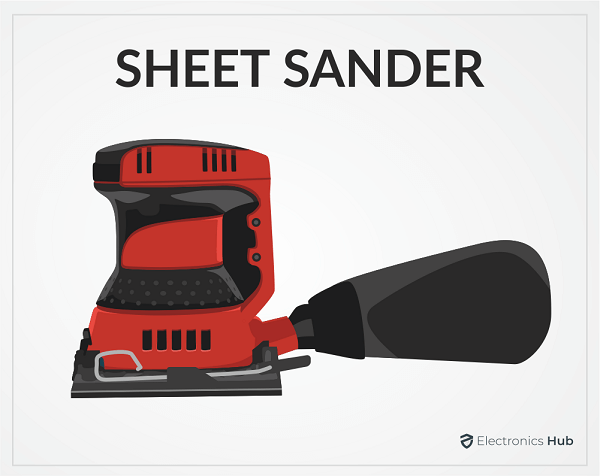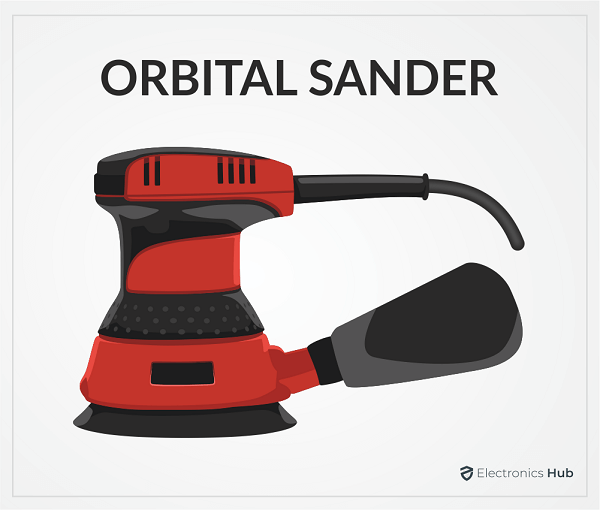Sanders are incredible pieces of tools. Sanding is the process of scuffing or polishing a surface with the help of an abrasive material. Sandpaper is the basic sanding tool that you can use for manual sanding. Coming to power tools, there are two popular sanders: Sheer Sanders and Orbital Sanders. In this guide, we will take a closer look at both these sanders. We will compare Sheet Sander vs Orbital Sander.
After that, we will list the pros and cons of Orbital and Sheet Sanders. Finally, we will conclude with applications and also where to use Sheet Sander vs Orbital Sander.
Outline
ToggleWhat is a Sheet Sander?

The sanding pad on a Sheet Sander has a rectangle shape. Combining this shape of the pad with the back-and-forth movement of the sander, you can use the Sheet Sander for detailing on smaller surfaces.
Due to the back-and-forth movement of the Sheet Sander, you cannot use it on large surfaces to remove huge layers of material in a single go.
The rectangle or square sanding pad of the Sheet Sander means that you can easily work on corners. When you compare the cost of Sheet Sander with other types of sanders, it is usually on the affordable side.
Also, the sandpaper that attaches to the Sheet Sander is just a regular sandpaper, which is available everywhere and cheap.
What is an Orbital Sander?

When we say “Random”, it refers to a random circular motion of the sanding pad. This movement of the sander results in an elliptical motion to achieve a scratch-free sanding.
You can use Orbital Sander for finishing wood as well as metal surfaces. The orbital sander is very easy to control and it not aggressive on the surface.
The extra power of the Orbital Sander means that you can use it on tougher surfaces for sanding through more layers. This is not possible with a mildly powered Sheet Sander.
Dust collection is an important part of the design of the Orbital Sander. The round sanding paper has pre-punched dust-collection holes. There will also be a dust collector at the end of the sander.
Pros and Cons
Sheet Sander
Pros:
+ The cost of Sheet Sander is less that other types of Sanders
+ You can use a regular sandpaper, which is available in all hardware stores
+ Excellent tool to work on corners and edges of wood or metal
+ The tool is very easy to use and lightweight
+ Suitable for finishing and smoothing of the surfaces
+ Available in different formats and styles (corded, cordless)
Cons:
– Not a very powerful tool
– Suitable only for surface finishing and not for multi-layer sanding
– Back-and-forth motion might leave swirl marks on the surface
Orbital Sander
Pros:
+ Very powerful tool
+ You can use for finishing as well as sanding layers, thanks to its powerful motor
+ Has a very useful dust collection mechanism
+ Random motion of the sanding pad ensures no marks on the surface
+ Some Orbital Sander models come with variable speed control setting
+ Very versatile tool
Cons:
– Due to circular pad and motion, it cannot reach corners or edges
– The cost of the tool and circular sanding pad is slightly more
– This power tool can be aggressive than Sheet Sander, especially if you are a beginner
Comparison of Sheet Sander vs Orbital Sander
Let us now see a side-by-side comparison of Sheet Sander vs Orbital Sander. We will take some important parameters and compare them in the following table.
| Parameter | Sheet Sander | Orbital Sander |
| Main Operation | Back-and-forth Motion | Random Circular Motion |
| Type of Sanding pad | Rectangular Sanding Pad | Circular Sanding Pad |
| Power | Medium power motor | High power motor |
| Suitable For | Finishing corners and edges | Sanding, smoothing as well as finishing wood and metal surfaces |
| Swirl Marks | Possible, especially for beginners | Circular motion minimizes marks on surface |
| Weight | Lightweight | Heavier than Sheet Sander but less fatigue |
| Cost | Affordable | Slightly expensive |
Which Tool Should You Get? Sheet Sander vs Orbital Sander
Now, the important question. Which sander should your get between Sheet Sander vs Orbital Sander? Let us see some simple suggestions.
Both the Sheet Sander and Orbital Sander are suitable for finishing and surface sanding. But the Random Orbital Sander is a more powerful and versatile tool.
You can get a decent Orbital Sander if you work on finishing surfaces, prepare the surface for painting, or applying seals.
Random Orbital Sander is also very useful for chipping the surface of wood or metal and also the paint layer.
Coming to Sheet Sander, they are slightly less-power tools that are very useful while working on finishing corners and edges of a surface.
If you are a professional, then we recommend you to get hold of both Sheet Sander and Orbital Sander. But keep in mind that the Random Orbital Sander is slightly expensive than the Sheet Sander.
Also Check: Best Electric DA Sander
Sheet Sander vs Orbital Sander – FAQs
Ans: For precision work, an orbital sander is often preferred due to its random orbital motion, which minimizes the risk of leaving swirl marks on the surface.
Ans: Yes, both types of sanders can be used for finishing tasks. However, orbital sanders are generally considered better for fine finishing due to their random orbital pattern.
Ans: Sheet sanders are not the best choice for material removal. They are more suitable for smoothing surfaces and finishing. Belt sanders or other aggressive sanders are better for rapid material removal.
Ans: Sheet sanders typically use rectangular sanding sheets that are secured to the sander’s base using clamps or clips.
Ans: Yes, orbital sanders use round sanding discs with a specific hole pattern to allow for efficient dust collection. Velcro-backed sandpaper discs are commonly used with orbital sanders.
Conclusion
Sanding is a very common part of finishing a surface, be it wood or metal. Sheet Sander and Orbital Sander are two popular power tools available for this purpose.
In this guide, we saw the basics of Sheet Sander and Orbital Sander. After that, we listed out the pros and cons of these power tools.
There is also a table with side-by-side comparison of Sheet Sander vs Orbital Sander. Finally, we saw which tool is suitable for you.

